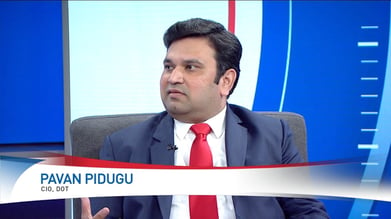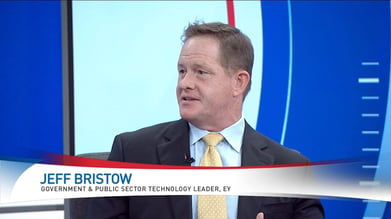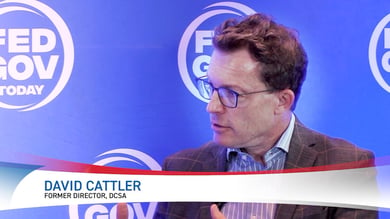In this episode of Fed Gov Today with Francis Rose, federal technology transformation takes center stage across three major conversations.
First, Pavan Pidugu, Chief Information Officer at the Department of Transportation (DOT), shares his ambitious vision for “OneDOT IT.” His goal is to unify the department’s fragmented technology landscape into a single enterprise operation by consolidating redundant systems, streamlining processes, and empowering IT professionals across DOT’s components. Pidugu emphasizes that this initiative isn’t just about saving money—it’s about improving digital services for citizens and creating new growth opportunities for the department’s workforce. Drawing from his experience at Walmart and within DOT’s Motor Carrier Safety Administration, he brings a fast-paced, product-focused approach to federal IT modernization.
Next, Jeff Bristow, Government and Public Sector Technology Leader at EY, discusses how agencies can reduce costs through smarter IT asset management without compromising mission delivery. He explains that modernization and savings can go hand in hand when agencies focus on mission outcomes first. Bristow highlights that thoughtful modernization can deliver rapid returns, reduce maintenance costs, and enhance user experience—particularly when adopting commercial best practices from industries like retail and finance.
Finally, David Cattler, former Director of the Defense Counterintelligence and Security Agency (DCSA), outlines how artificial intelligence is reshaping the federal security clearance process. While AI helps identify insider threats earlier, Cattler stresses that human judgment must remain central to trust decisions. Together, these discussions reveal a government IT landscape rapidly evolving toward greater efficiency, innovation, and accountability.
OneDOT IT: Uniting Technology and People at the Department of Transportation
In this episode of Fed Gov Today with Francis Rose, Pavan Pidugu, Chief Information Officer at the Department of Transportation (DOT), outlines his ambitious vision for “OneDOT IT.” Pidugu explains that the initiative focuses on streamlining processes, empowering people, and simplifying technology across all DOT components. Rather than chasing cost savings as the main goal, he says savings naturally follow when the department operates more efficiently and serves citizens better.
Pidugu’s plan brings IT staff from DOT’s subcomponents together into one cohesive organization, allowing employees to collaborate, grow professionally, and gain broader experience. He highlights examples like the department’s 14 separate grant systems, noting that consolidating overlapping tools will create a unified digital experience for users inside and outside the agency.
collaborate, grow professionally, and gain broader experience. He highlights examples like the department’s 14 separate grant systems, noting that consolidating overlapping tools will create a unified digital experience for users inside and outside the agency.
Drawing from his experience in both the private sector at Walmart and in DOT’s Motor Carrier Safety Administration, Pidugu applies a product-driven mindset to federal IT. He views technology as a living set of digital products designed to serve real needs and evolve over time. His ultimate goal: build a connected, efficient, and modern IT enterprise that empowers DOT employees and delivers smarter services to the public.
Key Takeaways:
- Pavan Pidugu’s OneDOT IT initiative unites DOT’s people, processes, and technology into one streamlined organization that eliminates redundancy and improves digital services.
- The consolidation gives IT employees more opportunities to grow, collaborate, and build long-term careers within the department.
- Pidugu brings a product-driven mindset to government IT, focusing on modern, user-centered tools that evolve to meet mission and citizen needs.
Smarter IT, Bigger Savings: How Agencies Can Modernize Without Sacrificing Mission
In this episode of Fed Gov Today with Francis Rose, Jeff Bristow, Government and Public Sector Technology Leader at EY, explains how federal agencies can cut costs while improving mission delivery through smarter IT asset management. He emphasizes that modernization and savings aren’t opposites—when done thoughtfully, they go hand in hand.
Bristow says agencies often think cost reduction means compromise, but in reality, modernization can save money and improve outcomes at the same time. By focusing first on the mission—what agencies are trying to achieve for their constituents—leaders can identify technologies that not only cost less to maintain but also make work more efficient and user-friendly.
He notes that modernization doesn’t have to take years. With deliberate planning, agencies can see a return on investment in months, not decades. While many organizations have already handled the “low-hanging fruit,” Bristow encourages them to take on legacy systems with courage and curiosity—asking why each system exists and whether a better, more flexible solution can replace it.
Drawing lessons from industries like retail and financial services, he says government can embrace commercial best practices to build a more agile, efficient, and sustainable IT future.
Key Takeaways:
- Modernizing IT systems can reduce costs and improve mission performance when agencies focus on outcomes first, not just savings.
- Agencies can realize quick returns on modernization investments, often seeing measurable benefits within months instead of years.
- By learning from commercial sectors like retail and finance, government can adopt proven best practices to create more flexible, efficient, and user-friendly systems.
AI and Trust: How DCSA Is Transforming Security Clearances and Insider Threat Detection
In this episode of Fed Gov Today with Francis Rose, David Cattler, former Director of the Defense Counterintelligence and Security Agency (DCSA), discusses how artificial intelligence is reshaping how the federal government detects and prevents insider threats. Cattler explains that DCSA is using AI and structured professional judgment tools to identify potential risks earlier and manage the vast amount of data involved in security vetting.
He makes it clear that while technology plays a critical role, AI will never replace human judgment when it comes to trust decisions. Determining whether a person or company can hold a clearance affects livelihoods, so accuracy, fairness, and responsibility are essential. AI helps DCSA process large data sets, spot anomalies, and prioritize cases, but the final trust call always remains with people.
essential. AI helps DCSA process large data sets, spot anomalies, and prioritize cases, but the final trust call always remains with people.
Cattler reflects on his leadership philosophy as he prepares to retire, saying his focus has been on empowering DCSA’s 15,000-person workforce to innovate, take smart risks, and find better ways to protect national security. He also emphasizes collaboration with industry, stressing that both sides share a common goal—safeguarding the nation’s security through integrity, trust, and partnership.
Key Takeaways:
- DCSA uses AI and data-driven tools to detect insider threats earlier and manage massive amounts of security information more effectively.
- Human judgment remains central to clearance and trust decisions—AI supports the process but never replaces people.
- Director David Cattler emphasizes empowering the workforce and partnering with industry to strengthen national security through collaboration and innovation.
